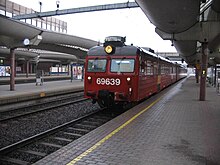NSB Type 69
| NSB Type 69 | |
|---|---|
|
Control car BS69.612 (front) and motor car BM69.012 (A-series) in Arendal
|
|
| Number: | 85 moves |
| Manufacturer: | Strømmens Værksted |
| Year of construction (s): | 1970-1990 |
| Axis formula : | Bo'Bo '+ 2'2' Bo'Bo '+ 2'2' + 2'2 ' |
| Gauge : | 1435 millimeters |
| Length over buffers: | End car: 24.85 m (A, B, C) 25.06 m (D, E, G) Middle car: 24.25 (B) 27 m (C, D, E, G) |
| Empty mass: | Railcar: 53.9 t (row A) 54 t (row B) 53.5 t (row C) 60.5 t (row D) 64 t (row E) Intermediate car: 28.8 t (row B) 35 t (Rows C and D) 38 t (row E) control car: 29 t (rows A and C) 28.5 t (row B) 35.5 t (row D) 37 t (row E) |
| Top speed: | 130 km / h |
| Installed capacity: | 1188 kW |
| Starting tractive effort: | 130 kN (A, B, C) 134 kN (D, E, G) |
| Motor type: | Norsk Elektrisk & Brown Boveri GRLM 2413Fe |
| Power system : | 15 kV, 16.7 Hz |
| Power transmission: | Overhead line |
| Number of traction motors: | 4th |
| Seats: | 189 seats (row A) 282–306 (row B three-part) 180–204 (row B two-part) 301 (row C) 300–303 (row D) 178 (row E) 270 (row G) |
NSB BM 69 or NSB Type 69 is the name of an electric multiple unit family that is used by the Norges Statsbaner for commuter traffic, on branch lines and sometimes over medium distances. It is the most common type of multiple unit in Norway. All trains were built by Strømmens Værksted .
Strictly speaking, BM69 is only the name of the railcars, but it is also used for the entire unit consisting of the railcar (BM), control car (BS) and any intermediate car (B).
The multiple units can be quickly coupled thanks to the automatic Scharfenberg coupling . It is possible to couple up to three types 69 and 70 units to form a multiple unit.
Series
The type BM69 is available in six series:
- The BM69A series was the original version, built in 1970 and 1971. A unit consists of two cars ( BM railcar and BS control car ). A total of 15 two-car units were built, three were parked by 2006.
- The successor type BM69B was manufactured in 1974. 18 of the total of 20 units consist of two cars, two were given an additional intermediate car B. Some trains were also retrofitted with enlarged luggage compartments in order to be able to use them on longer routes such as on the Bergensbane between Bergen and Myrdal , on which ski equipment or bicycles were often carried become. While the type 69A cars have two doors on each side, there is only one door on each side of the B series. This increases the number of seats, but slows down boarding and alighting.
- The successors BM69C were built in 1975 as three car trains (railcar BM, intermediate car B and control car BS). The total of 14 units are mostly used as commuter trains.
- A total of 39 trains from the BM69D series were built between 1983 and 1990. They also differ externally from their predecessors in the changed fronts.
- The BM69E series cars are D series units converted for use over medium distances. For example, the seat divider has been changed from 2 + 3 to 2 + 2. The series E units were first used on Gjøvikbane and Jærbane , now they operate between Bergen and Voss .
- The BM69G series was also created from series D trains. They also have a first class and are equipped with vending machines for snacks and drinks. The nine trains in the G series were converted in Denmark and run on the Gjøvik Railway.

Control car BS69.636 (row C) on arrival in Oslo S

Railcar BM69.078 in the new design in Lørenskog
Trains with names
Some of the trains have been given names.
| number | Surname | Period |
| 69025 | Freke | from 1998 |
| 69030 | Tjalve | 1992-2004 |
| 69031 | Idun | from 1998 |
| 69032 | Røskva | from 1993 |
| 69033 | Hugin | 1993-2005 |
| 69034 | Munin | from 1993 |
| 69035 | Eivind | from 1998 |
| 69050 | Knoll | 1983-1994 |
| 69051 | Dead | 1983-1994 |
Individual evidence
- ↑ NSB Type 69. Norsk Jerbaneklubb, accessed on 31 January 2015 (Norwegian).
Web links
Commons : NSB type 69 - collection of images, videos and audio files
- Type 69. In: jernbane.net. Retrieved September 9, 2015 (Norwegian).
- NSB vehicle details
- BM69 pictures
